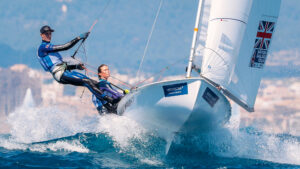What should an Olympic medal represent? Is it still sport’s ultimate accolade? Is it a demonstration that you’re the best in the world and have dedicated your entire life to…
Olympic sailing
‘I don’t want to watch sailing with a calculator’ – Matthew Sheahan on Olympic Sailing for Spectators
How was your summer season? If you went to a major event like Olympic sailing, did you wonder where everyone else was? Cowes Week seemed to stir up plenty of…
Olympic Sailing Penultimate Day Highlights: Golds for Britain, Italy, and Austria
Britain’s Ellie Aldridge closed the Olympic Sailing at Paris 2024 for Team GB on a huge high, saving the best performance of her career so far for kiting’s Olympic medal…
Olympic Sailing 2024 Highlights: Light Winds Delay Medal Races, Record Breaking Dinghy Medallists
The Olympic Sailing competitions in Marseille faced delays once again yesterday as the Medal Races for the Mixed Multihull and Mixed Dinghy were postponed due to a lack of wind.…
Unstoppable Australia: Wearn takes fourth-straight Olympic Sailing Dinghy gold
Winning the Men’s Olympic Dinghy medal race in an assured fashion, Matt Wearn today not only continued his nation’s extraordinary run of gold medal titles to four but became the…
How to watch Olympic sailing Multihull and Mixed Dinghy Medal Races
As is often the case for sailing at the Olympics, the sailing is actually taking place away from the main Olympic site for Paris 2024. The Olympic Sailing regatta will…
Olympic Sailing 2024: Shifting Winds and Tight Battles As Medal Race Day Looms for Most
The planned Medal Races for the Women’s and Men’s Dinghy (ILCA 6 and ILCA 7) could not take place due to a lack of wind yesterday, so Wednesday will see…
Olympic Sailing: Bouwmeester Olympic Greatest plus other Highlights from Day 9
The Olympic Sailing competition continues to deliver impressive performances as the challenging conditions in Marseille continue to push the sailors to their limits. With several races cancelled due to light…
Marit Bouwmeester secures second gold becoming greatest Olympic Female Sailor
As the capricious, fitful breezes finally expired in the intense late afternoon heat on the Bay of Marseille, when Race 10 for the Women’s Olympic Dinghy (ILCA 6) was abandoned…
Olympic Sailing 2024: Highlights from Day 8 in Marseille
The 2024 Olympic Sailing competition continued with notable performances across multiple categories. The poor conditions might have seen some surprise winners so far, but the stage is set for a…
Italy’s Magetti secures gold but it’s heartbreak for British Olympic windsurfing star
Britain’s iQFOiL windsurfer Emma Wilson failed to beat Olympic sailing’s cruellest, toughest made-for- TV medal format again as she landed the bronze medal finishing behind Italy’s Martta Magetti and Israel’s…
How to watch Olympic windsurfing Medal Racing live streams from anywhere
Windsurfing has been a part of the Olympic sailing competition since the 1980s, but Olympic windsurfing in Paris 2024 is the first time we will see a foiling windsurfer take…
Favourites take top Olympic Skiff Sailing medals after dramatic Marseille Medal Races
Riding a huge wave of confidence after guiding Spain to victory as underdogs in Sail GP’s grand final in San Francisco, Diego Botin and Florian Trittel produced a gun-to-gun medal…
Emma Wilson: Team GB Olympic Windsurfing double-medallist
Britain’s Emma Wilson has dominated the Women’s Olympic Windsurfing event at Paris 2024 securing a medal with a day to spare. She adds this second medal to the bronze she…
Olympic Sailing: Medals Guaranteed & Other Highlights from Day Six in Marseille
Thursday was supposed to see Medal Racing for the Men’s Olympic Skiff, the 49er and Women’s Olympic Skiff, the 49er FX. However despite the Men getting their race started on…
World’s Coolest Boats: The Olympic 470 class
The two-man 470 dinghy was designed by André Cornu over 50 years ago and been an Olympic boat since 1976. At the Olympic Sailing in Paris 2024 it will be…
8 bite-sized lessons I needed to understand how Olympic sailing works
What I love about the Olympics is that I find myself leaning forward in anticipation when watching sports I wouldn’t usually do. The Olympics is like a buffet with food…
Olympic Sailing 2024: Highlights from Day Five in Marseille
The Olympic Sailing competition in Marseille continued to deliver excitement and drama as competitors battled challenging conditions ahead of the crucial Medal Races for the Men’s Skiff and Women’s Skiff,…
Olympic Sailing 2024: Highlights from Day Four in Marseille
The third day of the Olympic Sailing competition in Marseille saw a continuation of the shifty weather that we have seen in the opening days, but an increase in wind…
A slow hot start but a glamour Olympic sailing weekend lies ahead
It has long been held that the Olympic sailing medallists emerging from the Paris 2024 Olympic Games will be the athletes best able to perform across a wide range of…































